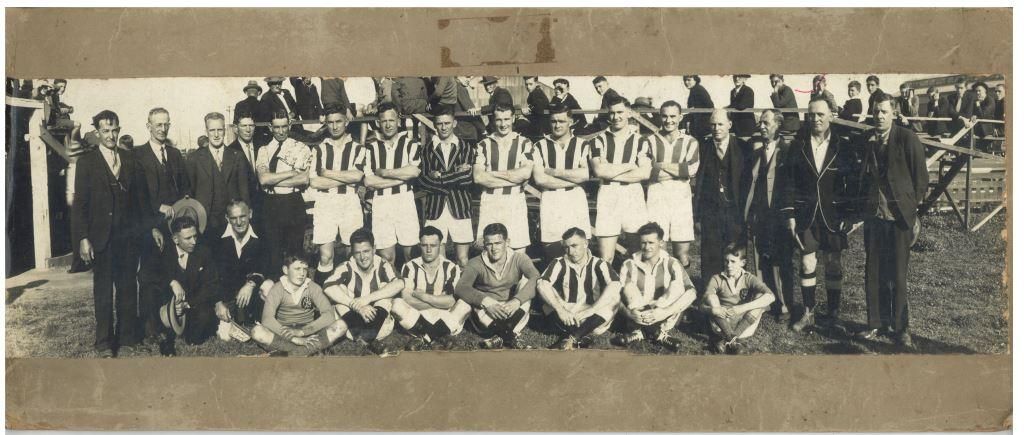
Our Granville Football Association Collection provides us with a useful example on how to condition report different museum objects, including photographs, fabric pennants, paper items and textiles. After being accessioned, each object requires careful handling, documentation, condition reporting, and appropriate storage.
Condition reporting should ideally take place on a large, empty table with a non-slip coating to protect the objects. The area should also be well-lit and have a flexible lamp for detailed examination. A basic condition reporting toolkit includes pencils, ruler, a soft tape measure, a magnifying lens to closely examine items, tweezers for lifting fine items, a soft bristle brush, and gloves.
Each object should then be individually documented, with both a description of the object and its dimensions, as well as a summary of the object’s condition.
For example, the photograph below is showing signs of foxing and is lifting away from its backing board. Hence, this item would be described as:
![Granville District Soccer and Football Club Studio Portrait [ACC171.001.060] Source: Parramatta Heritage Centre](/sites/phh/files/wp-images/2015/10/ACC171.1.060.jpg)
Granville District Soccer and Football Club Studio Portrait [ACC171.001.060] Source: Parramatta Heritage Centre
Fair, some discoloration in upper left and right corners, lifting along top edge, all corners creased and worn. There are small holes in the upper left and right and lower corners, possibly from tacks. Backing board showing signs of water damage
These details should be recorded and dated so that the object can be condition reported at a later date, with the possibility of undertaking some conservation work if it appears to still be actively deteriorating. A simple excel spreadsheet is Okay to start with as they can be imported into most museum database management systems.
Once an object has been assessed, measured and photographed, it needs to be stored in a stable environment. In the case of this photograph, it will be stored in an acid-free mylar sleeve, within an archival box.
Different objects require varying forms of treatment. For example, as you can see in the photograph below, these cloth badges cannot be directly numbered, so instead have had a small cotton strip with an identification number sewn on the reverse side. As a general rule, all modifications and repairs to an object should be easily reversible.
![Granville District Soccer and Football Club Cloth Badges [ACC171.007.005] Source: Parramatta Heritage Centre](/sites/phh/files/wp-images/2015/10/ACC171.007.005-1024x639.jpg)
Granville District Soccer and Football Club Cloth Badges [ACC171.007.005] Source: Parramatta Heritage Centre
As these badges are quite flat, they have been wrapped in archival grade un-buffered tissue, before being stored in archival boxes.
Similarly, the 1914 Granville Premiership caps have had small cotton tape identification tags sewn on in an inconspicuous location. A custom storage solution has been created using Ethafoam (an intert close-celled foam], wadding, and cotton fabric, to maintain the cap’s shape and provide support to any weakened sections of the fabric.
![Granville District Soccer and Football Club Premiership Cap [ACC171.003.001] Source: Parramatta Heritage Centre](/sites/phh/files/wp-images/2015/10/ACC171.003.001_1-1024x683.jpg)
Granville District Soccer and Football Club Premiership Cap [ACC171.003.001] Source: Parramatta Heritage Centre



